User Manual
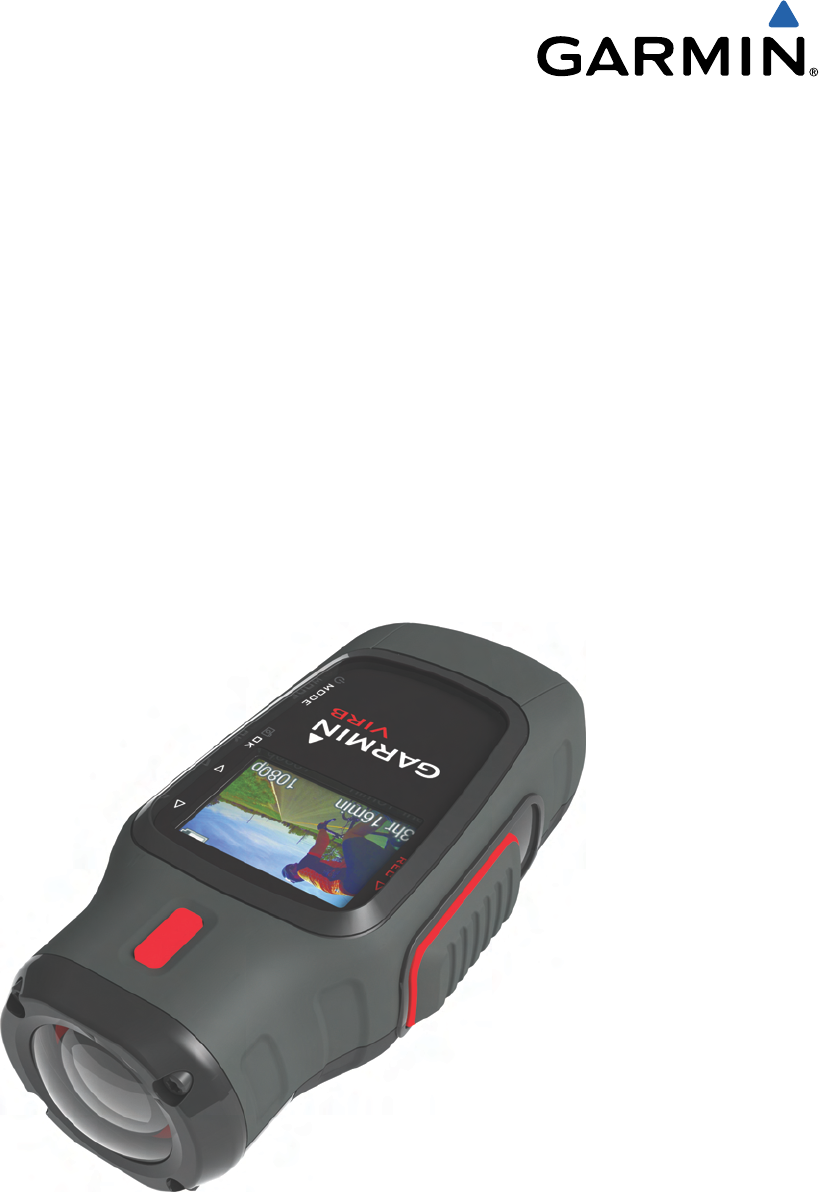
VIRB™ Series
Owner’s Manual
August 2013 190-01627-00_0A Printed in Taiwan
All rights reserved. Under the copyright laws, this manual may not be copied, in whole or in part, without the written consent of Garmin. Garmin reserves the
right to change or improve its products and to make changes in the content of this manual without obligation to notify any person or organization of such
changes or improvements. Go to www.garmin.com for current updates and supplemental information concerning the use of this product.
Garmin® and the Garmin logo are trademarks of Garmin Ltd. or its subsidiaries, registered in the USA and other countries. VIRB™, ANT+™, and BaseCamp™
are trademarks of Garmin Ltd. or its subsidiaries. These trademarks may not be used without the express permission of Garmin.
microSD™ and the microSDXC logo are trademarks of SD-3C, LLC. Mac® is a trademark of Apple Inc. Microsoft® and Windows® are registered trademarks
of Microsoft Corporation in the United States and other countries. HDMI® is a registered trademark of HDMI Licensing, LLC. Wi-Fi® is a registered mark of
Wi-Fi Alliance Corporation. Other trademarks and trade names are those of their respective owners.

Table of Contents
Introduction.................................................................... 1
Installing a Memory Card........................................................... 1
Installing the Battery Pack......................................................... 1
Charging the Lithium-Ion Battery Pack...................................... 1
Keys........................................................................................... 2
Mounting the Device.................................................................. 2
Turning On the Device............................................................... 2
Modes........................................................................................ 3
Viewfinder....................................................................... 3
Leveling the Device.................................................................... 3
Status Page............................................................................... 3
Video............................................................................... 3
Recording a Video..................................................................... 3
Video Settings............................................................................ 4
Advanced Recording Settings.................................................... 4
Recording Video Automatically.................................................. 4
Recording a Time Lapse Video.................................................. 4
Recording a Video Loop............................................................ 5
Connecting an External Microphone or Audio Source............... 5
Photos............................................................................. 5
Taking a Photo........................................................................... 5
Photos Settings.......................................................................... 5
Taking a Delayed Photo............................................................. 5
Taking Repeated Photos........................................................... 5
Playback......................................................................... 5
Viewing Photos and Videos....................................................... 5
Viewing Video Over HDMI®....................................................... 6
Connecting Headphones........................................................... 6
Outputting Composite Video...................................................... 6
Deleting Photos and Videos....................................................... 6
Tracks............................................................................. 6
Recorded Track Log Data.......................................................... 6
Dashboards.................................................................... 7
Viewing the Dashboards............................................................ 7
Pairing Your ANT+ Sensors....................................................... 7
Remote Control.............................................................. 7
Controlling the Device Remotely................................................ 8
Controlling Multiple VIRB Devices Remotely............................. 8
Operating the Device Using Your Mobile Device....................... 8
Troubleshooting.............................................................8
My device does not turn on........................................................ 8
My device display is hard to see................................................ 8
Some information is missing from the dashboards.................... 8
My video recordings do not look smooth................................... 8
My device turns off when I stop recording video........................ 8
Device Information.........................................................8
System Settings......................................................................... 8
Erasing Your Memory Card....................................................... 9
Extending the Battery Life.......................................................... 9
Device Care............................................................................... 9
File Types.................................................................................. 9
Connecting the Device to Your Computer................................. 9
Support and Updates................................................................. 9
Specifications............................................................................. 9
Getting More Information........................................................... 9
Index..............................................................................10
Table of Contents i
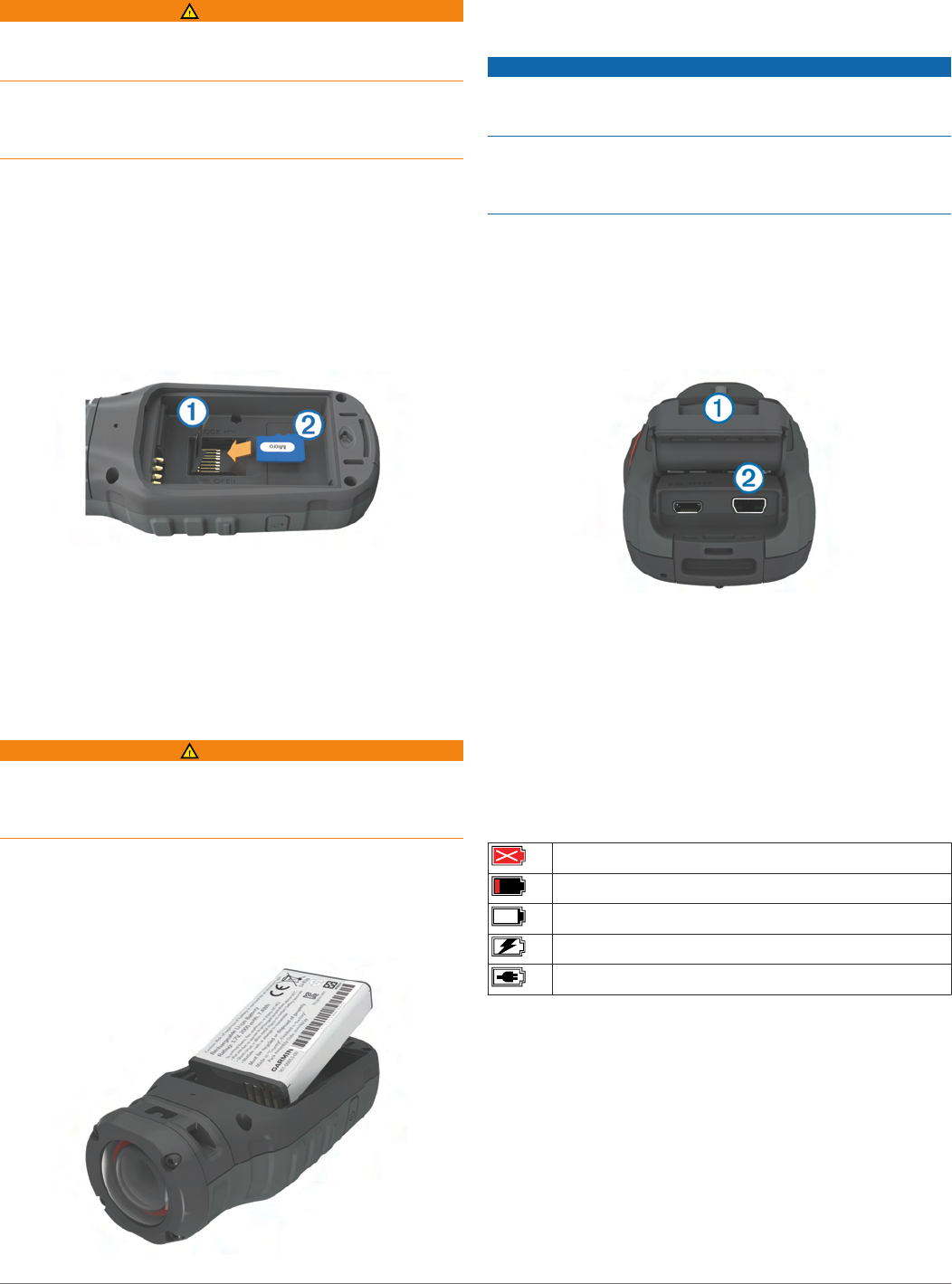
Introduction
WARNING
See the Important Safety and Product Information guide in the
product box for product warnings and other important
information.
It is your responsibility to use the device in a safe manner.
Garmin® will not be responsible for any property damage,
injuries or deaths resulting from any use of this device in any
activities.
Installing a Memory Card
You must install a microSD™ memory card up to 64GB to use
your device. For optimal performance, use a class 10 or better
memory card.
1Turn the D-ring counter-clockwise, and pull up to remove the
cover.
2If necessary, remove the battery pack.
3In the battery compartment, slide the card holder À toward
the lens, and lift up.
4Place the memory card Á with the gold contacts facing
down.
5Close the card holder.
6Slide the card holder away from the lens to lock it.
7Replace the battery pack.
8Replace the battery cover, and turn the D-ring clockwise.
Installing the Battery Pack
WARNING
This product contains a lithium-ion battery. To prevent the
possibility of personal injury or product damage caused by
battery exposure to extreme heat, store the device out of direct
sunlight.
1Turn the D-ring counter-clockwise, and pull up to remove the
cover.
2Locate the metal contacts on the end of the lithium-ion
battery.
3Insert the battery into the compartment, contacts first.
4Press the battery into place.
5Replace the battery cover, and turn the D-ring clockwise.
Charging the Lithium-Ion Battery Pack
NOTICE
To prevent corrosion, thoroughly dry the mini-USB port, the
weather cap, and the surrounding area before charging or
connecting to a computer.
Do not attempt to use the device to charge a battery that was
not provided by Garmin. Attempting to charge a battery that was
not provided by Garmin can damage the device and void the
warranty.
NOTE: The battery will not charge when outside the
temperature range of 32 to 114°F (0 to 45°C).
You can charge the battery using a standard wall outlet or a
USB port on your computer. You can also use an optional
battery charger accessory. Go to www.garmin.com/outdoor for
more information.
1Pull up the weather cap À from the mini-USB port Á.
2Plug the small end of the USB cable into the mini-USB port.
3Plug the USB end of the cable into the AC adapter or a
computer USB port.
4Plug the AC adapter into a standard wall outlet.
When you connect the device to a power source, the device
turns on. The LED is orange while the battery is charging.
5Charge the battery completely.
The LED turns green when the battery is fully charged.
6Remove the USB cable and fully close the weather cap.
Battery Status
Critically low battery or missing battery
Low battery
Remaining battery
Charging
Fully charged
Saving Energy While Charging the Device
You can turn off the device display and all other features while
charging.
1Connect your device to an external power source.
The remaining battery capacity appears.
2Hold the power key for 4 to 5 seconds.
The display turns off, and the device goes into a low power,
battery charging mode.
3Charge the device completely.
Introduction 1
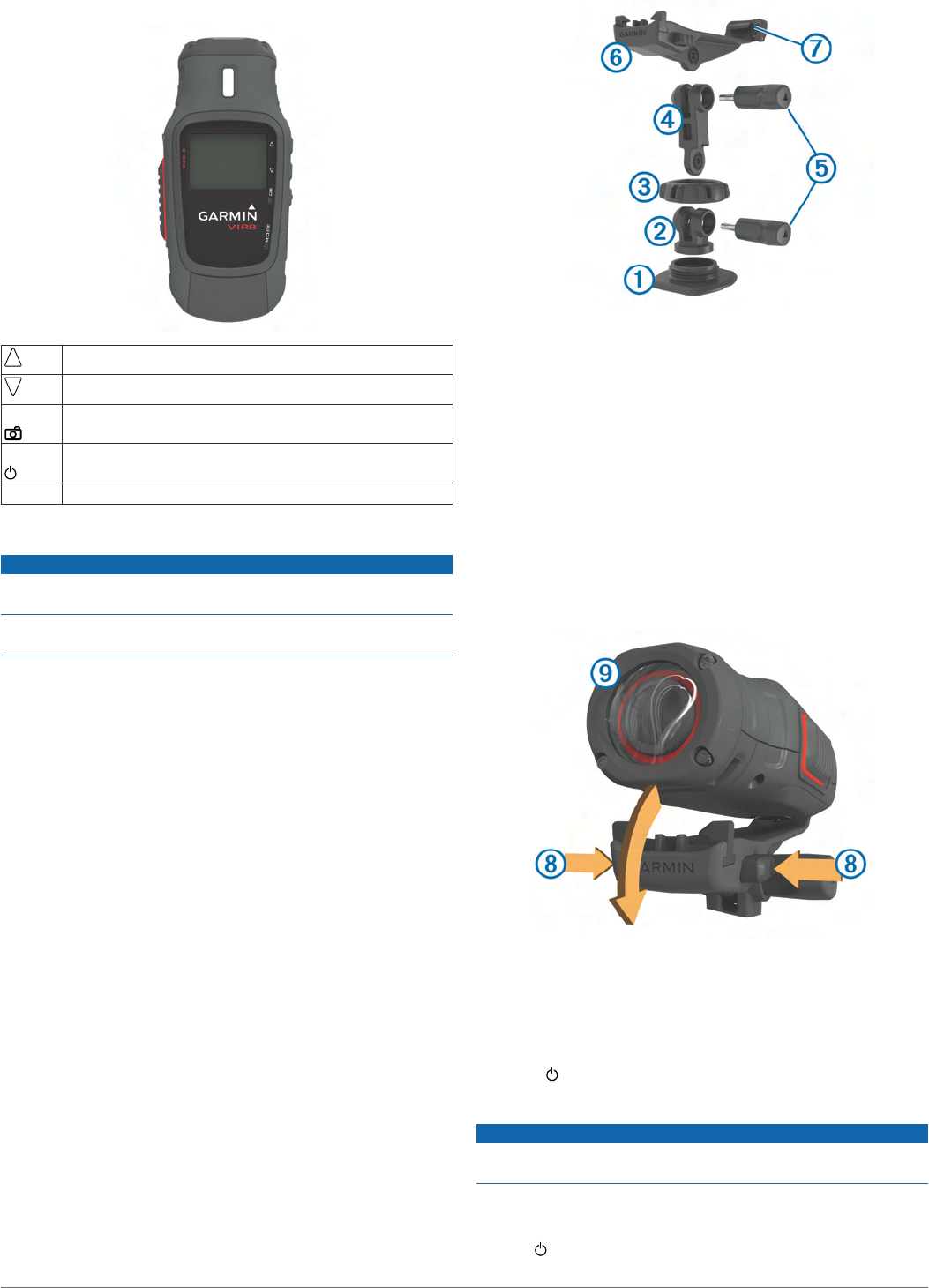
Keys
Select to scroll through menus and settings.
Select to scroll through menus and settings.
OK Select to choose menu options or to take a photo.
MODE Select to scroll through modes.
Hold to turn the device on and off.
REC Slide toward the lens to record video.
Mounting the Device
NOTICE
To prevent product loss or damage, do not use the mounting
base when the temperature is below 5°F (-15°C).
The permanent mounting adhesive is extremely difficult to
remove after it is installed.
Before you can install the mounting base onto a surface, the
ambient temperature must be from 70° to 100°F (from 21° to
38°C).
Your device includes an assortment of mounting bases and
arms, which can be used in many configurations. These
instructions provide an example of one possible configuration.
You can also purchase additional mounts for your device, such
as wearable mounts, vehicle mounts, or a tripod mount. Go to
www.garmin.com/outdoor for more information.
NOTE: By default, the camera should be mounted with the
screen facing up to record correctly oriented video. You can
adjust the settings to record with the screen facing down
(page 4).
1Thoroughly clean the mounting surface using water or
alcohol.
2Remove the film from the base À, and press the base firmly
onto the mounting surface.
You can use either the flat base or the curved base,
depending on the contour of the mounting surface.
3Allow the base to bond to the mounting surface for at least
24 hours.
4Place the coupler Á into the base.
5Place the threaded ring  over the coupler, and tighten it
onto the base.
6Snap the mounting arm à into the coupler.
7Insert a thumbscrew Ä into the larger opening of the joint,
and tighten the thumbscrew to lock the angle of the joint.
8Snap the camera mount Å into the top of the mounting arm.
9Insert a thumbscrew into the larger opening of the joint, and
tighten the thumbscrew to lock the angle of the joint.
10Place the tab Æ on the back of the camera mount into the
slot in the back of the camera.
11Squeeze the buttons Ç on the sides of the mount, press the
front of the camera È down, and release the buttons.
The camera should be held tightly and should not move in
the mount when properly secured.
12If the camera feels loose in the mount, press the front of the
camera into the mount until it clicks.
Turning On the Device
Select .
Turning Off the Device
NOTICE
To prevent loss of data, always turn off the device before
removing the battery.
NOTE: You cannot turn off the device while recording video.
1If necessary, slide REC away from the lens.
2Hold .
2 Introduction
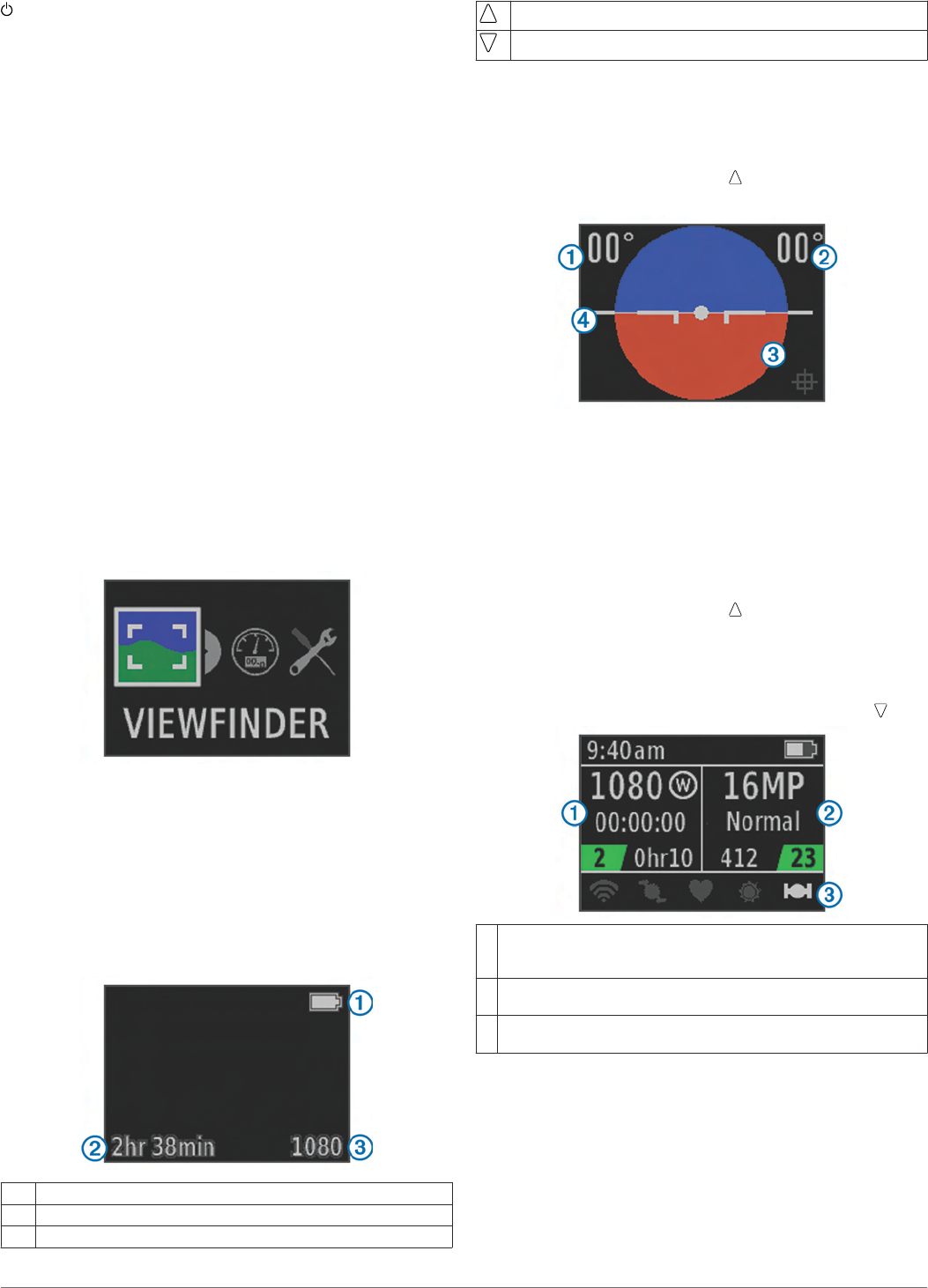
appears on the screen while the device saves track log data
and turns off.
If you need to remove the battery, wait until the screen turns off
before removing the battery.
Turning the Device On and Off Using REC
You can use REC to turn the device on and off in recording
mode. This feature allows you to start recording quickly, while
automatically turning off the device to conserve battery power
when you are not recording.
NOTE: The device does not turn off using REC unless you use
REC to turn on the device.
1With the device turned off, slide REC toward the lens.
The device turns on and starts recording video.
2When you are finished recording, slide REC away from the
lens.
The device stops recording and turns off.
Modes
You can operate your device in several modes.
VIEWFINDER: Displays the camera viewfinder and status
information.
PLAYBACK: Allows you to view recorded videos and photos.
DASHBOARD: Displays sensor data in charts and data fields
(VIRB Elite only).
SETUP: Allows you to change camera settings.
Changing Modes
1Select MODE to cycle through the available modes.
The modes cycle from left to right. The icon for the selected
mode appears larger, and the name of the selected mode
appears at the bottom of the screen.
2Stop selecting MODE when the desired mode appears.
Viewfinder
You can use the viewfinder to set up shots, view status
information, and level the camera (VIRB Elite only).
Select MODE > VIEWFINDER.
ÀBattery status
ÁRecording time remaining on the memory card
ÂCurrent video mode
Select to view the level (page 3).
Select to view the status page (page 3).
Leveling the Device
NOTE: This feature is available for VIRB Elite only.
You can use the on-screen level when you mount the device to
ensure your videos and photos are perfectly level.
1Select MODE > VIEWFINDER > .
The level appears.
2Adjust the device until the degree of roll À and degree of
pitch Á are both 00°, and the brown section of the level  is
even with the horizon line Ã.
Calibrating the Level
You can calibrate the level if it does not seem accurate. It may
be necessary to calibrate the level when using the device in
extreme temperatures.
1Place the device flat on a level surface, with the screen
facing up.
2Select MODE > VIEWFINDER > .
3Select OK.
Status Page
The status page provides at-a-glance details about the current
settings of your device. Select MODE > VIEWFINDER > .
ÀDisplays the video mode, field of view, elapsed time, interval or
loop setting (if set), number of videos, and time remaining on the
memory card.
ÁDisplays the photo resolution, camera mode, timer count (if set),
photos remaining, and number of photos.
ÂDisplays the sensors (VIRB Elite only) including Wi-Fi®, cadence,
heart rate, tempe™, and GPS.
Video
Recording a Video
NOTE: If the battery power becomes very low while recording
video, the device automatically stops recording, saves the
video, and safely turns off.
1Slide REC toward the lens to start recording video.
If the device is off, it turns on automatically. The device starts
recording video, and the viewfinder appears.
Viewfinder 3

The viewfinder displays the recording status À, the GPS and
battery status Á, and the elapsed recording time Â.
2When you are finished recording video, slide REC away from
the lens.
The video is saved on the memory card as an MP4 file, and
the track log for the video is saved on the memory card as a
GPX file.
Video Settings
Select MODE > SETUP > VIDEO.
Mode: Sets the resolution, aspect ratio, and frame rate.
Field of View: Sets the zoom level.
Loop: Enables loop recording and sets the number of minutes
of video to store when recording a video loop.
Auto Record: Enables automatic recording (VIRB Elite only).
Microphone: Enables the microphone.
NOTE: This setting is not available when the device is
connected to an external microphone.
TIP: If wind noise is an issue when recording video, you can
disable the microphone.
Video Modes
You can set the resolution, aspect ratio, frame rate, and speed
of recorded video. The resolution is the width and height of the
video, in pixels. The aspect ratio is the ratio of the video width to
the video height. Standard widescreen televisions use a 16:9
aspect ratio, and standard full screen televisions use a 4:3
aspect ratio. The frame rate is expressed in frames per second
(fps). The speed indicates the speed of action in the video
compared to real time.
1080p: Use this mode when you need high-resolution
widescreen shots. 1080p works well as a default setting.
Tall HD: Use this mode when you need a large, vertical viewing
area. Tall HD is particularly useful for close-up action shots
and when using a helmet mount.
Fast HD: Use this widescreen mode to capture high-speed
action shots.
Economy HD: Use this widescreen mode when you need a
longer recording time. Economy HD uses less space on
your memory card.
Slow Mo HD: Use this widescreen mode to capture handheld
shots with slow-motion playback.
Super Slow Mo: Use this mode when you need super slow-
motion playback in standard definition.
Time Lapse: Use this high-resolution widescreen mode to
capture slow-moving or long-term action.
Video Mode Specifications
Mode Resolution
(pixels)
Aspect
Ratio
Frame
Rate (fps)
Speed
1080p 1920×1080 16:9 30 Normal
Tall HD 1280×960 4:3 48 Normal
Fast HD 1280×720 16:9 60 Normal
Economy HD 1280x720 16:9 30 Normal
Mode Resolution
(pixels)
Aspect
Ratio
Frame
Rate (fps)
Speed
Slow Mo HD 1280×720 16:9 60 1/2 speed
Super Slow Mo 848×480 16:9 120 1/4 speed
Time Lapse 1920×1080 16:9 30 Varies
Field of View
You can change the field of view when Lens Correct is set to
Off. Select MODE > SETUP > VIDEO > Field of View.
Wide: Captures a wide view of your surroundings. Use this
mode for open areas, close-range video, and when you want
to capture as much of your viewing area as possible.
Zoom (2x): Captures a tighter view. Use this mode for medium-
range video.
Ultra-Zoom (4x): Captures a very focused view. Use this mode
for long-range video and closed or covered surroundings.
Advanced Recording Settings
Select MODE > SETUP > ADVANCED.
Lens Correct: Corrects wide-angle barrel distortion and
reduces the field of view. Automatically sets Field of View to
Wide in the video settings. On+Stabilize turns on image
stabilization to reduce shaky video.
Flip Camera: Sets the camera to capture video and images
with the screen facing up or down. This Side Down captures
correctly oriented video and photos with the screen facing
downward.
Inverting the Camera Orientation
You can change the camera orientation of your device to easily
access REC during an activity. If you are mounting the device
above your head, you can invert the camera orientation to aid
visibility of the recording light or display.
1Select MODE > SETUP > ADVANCED > Flip Camera.
2Select an option:
• Use This Side Up to use the device with the screen
facing upward.
• Use This Side Down to use the device with the screen
facing downward.
Recording Video Automatically
NOTE: This feature is available for VIRB Elite only.
You can set the device to record video automatically based on
your activity. This feature allows you to conserve space on your
memory card by recording only the important parts of your
activity.
1Select MODE > SETUP > VIDEO > Auto Record.
2Select an option:
• To record video automatically when the device is moving,
select When Moving.
The device records video when you are moving and stops
recording when you are still.
• To record video automatically when you are skiing, select
Ski Mode.
The device records video when you are moving downhill
and stops recording when you board the chairlift.
This feature automatically enables GPS in the system settings.
Recording a Time Lapse Video
Time lapse mode captures individual video frames at longer
intervals and creates a video that plays much faster than real
time. You can use time lapse to record movements, changes, or
events that take place over a long period of time.
4 Video

Time lapse videos play at 30 frames per second. The length of
the video depends on the amount of time between video
frames. For example, if frames are recorded at a one-second
interval, each second of video covers 30 seconds of real time. If
frames are recorded at a 60-second interval, each second of
video covers 30 minutes of real time.
1Select MODE > SETUP > VIDEO > Mode > Time Lapse.
2Select a time interval.
3For the best results, mount the device so that it will not move
while recording.
4Record a video.
Recording a Video Loop
Loop mode allows you to record video continuously but save
only the most recent video footage. You can select the number
of minutes of video to save. This enables you to save storage
space when you want to capture key moments but do not want
to save all footage of an activity. This feature is useful when
using the device as a driving recorder.
The saved video loop is split into multiple files of equal length.
This allows you to delete unwanted portions of the video easily.
1Select MODE > SETUP > VIDEO > Mode > Loop.
2Select the number of minutes of video to save.
Max uses all available storage space on the memory card.
3Start recording video.
4When finished, stop recording.
The most recent footage is saved on the memory card, up to the
number of minutes selected in step 2.
Connecting an External Microphone or
Audio Source
Before you can connect an external microphone, you must
purchase a VIRB accessory cable with audio input. Go to
www.garmin.com/outdoor. You must also have an external
microphone or audio source with a 3.5 mm connector.
When you connect an external microphone, the device records
audio from the external microphone instead of the built-in
microphone.
1Pull up the weather cap from the mini-USB port.
2Connect mini-USB plug on the accessory cable to the mini-
USB port on the device.
3On the device, when prompted to output video, select No.
4On the device, when prompted to use an external
microphone, select Yes.
5Connect the microphone to the MIC IN connector on the
accessory cable.
To stop using the external microphone, you must disconnect the
accessory cable from the device.
Photos
Taking a Photo
Your device provides several methods for taking a photo.
• Select MODE > VIEWFINDER, aim the camera using the
viewfinder, and select .
• From anywhere except the playback screen, hold .
The device displays the photo briefly and returns to the page
you were using.
• While recording a video, select to capture a photo at the
same resolution as the video recording.
Photos taken while recording a video always use normal
photo mode. Burst mode is ignored while recording video.
Photos Settings
Select MODE > SETUP > Photos.
Resolution: Sets the photo resolution to 16 MP (4:3), 12 MP
(16:9), or 8 MP (4:3).
Mode: Sets the shooting mode. Burst mode takes several
photos in quick succession to capture a specific instance,
such as the finish line during a race.
Self Timer: Sets the timer to delay taking a photo. Repeat On
automatically repeats the time interval and captures a photo
until you press again.
Date Stamp: Adds a date stamp to your photo.
Photo Modes
Select MODE > SETUP > Photos > Mode.
Normal: Takes a single photo using automatic exposure.
Burst: Rapidly takes three 16MP images, five 12MP images, or
ten 8MP images in one second. Burst mode is ideal for
capturing photos of people or objects in motion.
Taking a Delayed Photo
You can delay taking a photo using the self timer. This allows
you to join or adjust a shot before the photo is taken.
1Select MODE > SETUP > Photos > Self Timer.
2Select a delay time.
3Select Repeat Off.
Repeat Off is not an option when Burst mode is enabled.
4Select MODE > VIEWFINDER.
5Select .
The countdown timer displays the remaining time until the
photo is taken, in seconds.
Taking Repeated Photos
You can use the self timer to take repeated photos at a set time
interval. This enables you to take several photos of a subject or
to take a series of time-lapse photos.
1Select MODE > SETUP > Photos > Self Timer.
2Select a time interval between photos.
3Select Repeat On.
4Select MODE > VIEWFINDER.
5Select .
The device takes repeated photos at the selected interval.
The viewfinder displays the GPS and battery status À, the
time in seconds until the next photo is taken Á, and the
number of repeated photos the device has taken Â.
6Select to stop taking photos.
Playback
Viewing Photos and Videos
You can view your photos and recorded videos on the device
screen.
Photos 5
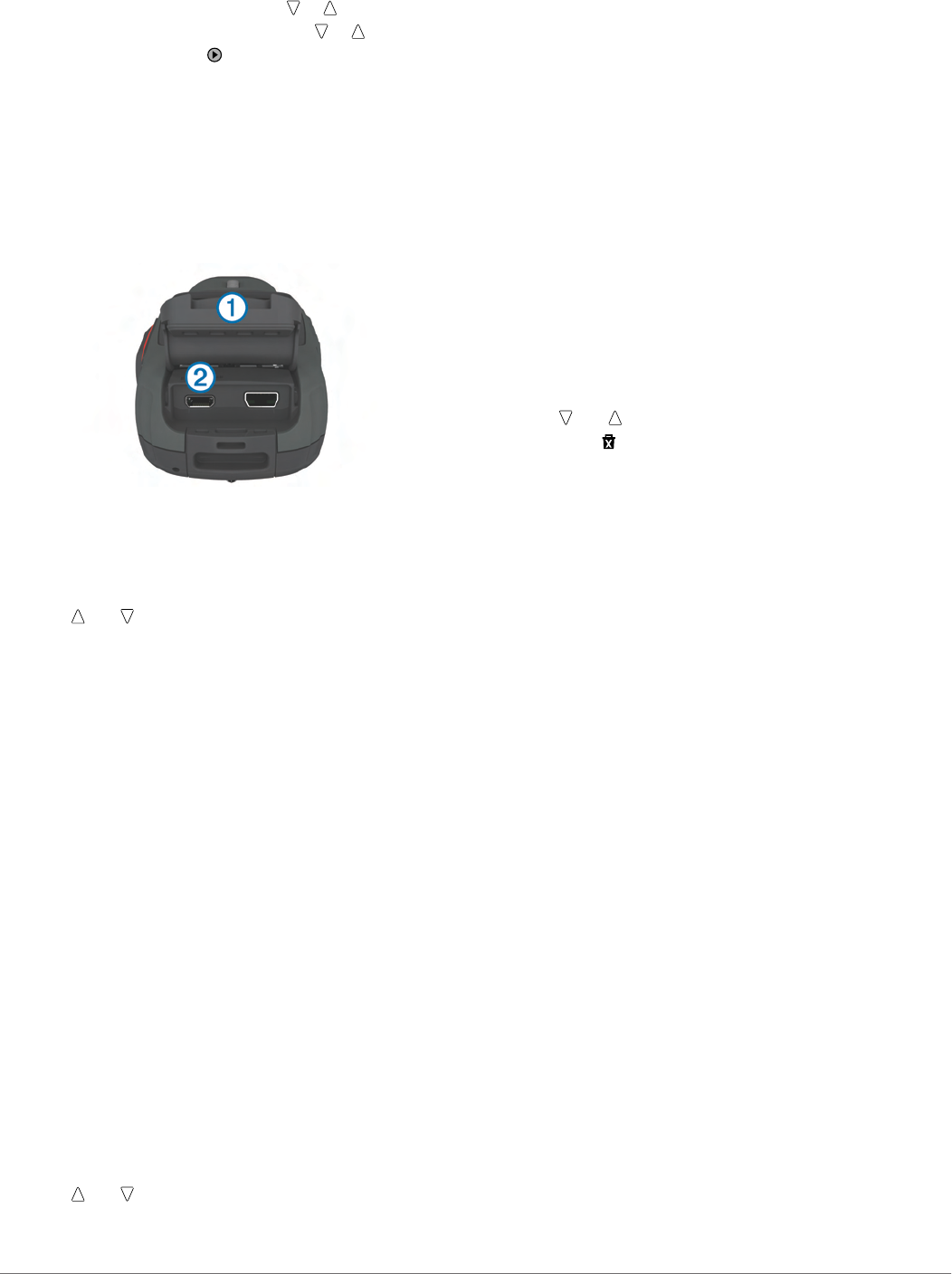
1Select MODE > PLAYBACK.
2Select an option:
• To select a photo or video, select or .
• To quickly scroll through the list, hold or .
Videos are indicated with . Videos and photos are sorted
by date and time with the most recent item listed first.
3Select OK.
You can control video playback using the on-screen controls.
Viewing Video Over HDMI®
You can connect your device to an external display using an
HDMI-to-micro HDMI cable (not included).
1If necessary, turn on the device.
2Pull up the weather cap À from the micro HDMI port Á.
3Plug the small end of the HDMI cable into the micro-HDMI
port.
4Plug the large end of the cable into an available HDMI port
on the external display.
5On the device, select MODE > PLAYBACK.
6Select and to select a video.
7Select OK.
The video plays on the external display.
Connecting Headphones
Before you can connect headphones to your device, you must
purchase the VIRB audio-video cable accessory. Go to
www.garmin.com/outdoor.
Using headphones, you can monitor the audio when recording a
video and listen to your recorded video in PLAYBACK on the
device.
1Pull up the weather cap from the mini-USB port.
2Connect the mini-USB plug on the audio-video cable to the
mini-USB port on the device.
3Connect the headphones to the 3.5 mm AUDIO OUT
connector on the audio-video cable.
Your device automatically detects the audio-video cable and
displays a setup wizard.
4On the device, when prompted to output video, select No.
5On the device, when prompted to use an external
microphone, select No.
To stop using the headphones, you must disconnect the audio-
video cable from the device.
Adjusting the Volume
When headphones are connected to your device, you can
adjust the volume.
1Select MODE > SETUP > SYSTEM > Audio Out.
2Select and to change the volume level.
3Select OK.
Outputting Composite Video
Before you can output composite video, you must purchase the
VIRB audio-video cable accessory. Go to www.garmin.com
/outdoor. You must also have an RCA composite video cable
and a 3.5 mm stereo audio cable.
You can play video on an external display using composite
video and stereo audio.
1Pull up the weather cap from the mini-USB port.
2Connect mini-USB plug on the audio-video cable to the mini-
USB port on the device.
3On the device, when prompted to output video, select Yes.
4Connect an RCA composite video cable to the composite
video output connector of the audio-video cable and to an
available port on your external display.
5Connect a 3.5 mm audio cable to the AUDIO OUT connector
on the audio-video cable and to an available port on your
external display.
TIP: If your external display requires RCA audio input, you
can use a 3.5 mm-to-RCA adaptor cable.
Deleting Photos and Videos
1Select MODE > PLAYBACK.
2Select and to select a photo or video.
3Select OK > .
Tracks
NOTE: This feature is available for VIRB Elite only.
A track is a recording of your path. The track log contains
information about points along the recorded path, such as time,
location, and elevation for each point. If you have paired
ANT+™ sensors with your device, data from connected sensors
is included in the track log.
The device records a continuous track log while it is on. This
track is saved as a FIT file on the memory card each time you
turn off the device. The device also records a separate track log
for each video recording. Video track logs are saved as GPX
files on the memory card each time you stop recording video.
The track logs include track point data at one-second intervals.
You can view GPX and FIT track logs on your computer using
the BaseCamp™ application. Go to www.garmin.com/basecamp
for more information. You can also view and upload FIT track
logs to Garmin Connect™. Go to http://connect.garmin.com for
more information.
Recorded Track Log Data
Each point in the track log records your GPS location and data
from available sensors. The device can record these categories
of data in the track log.
• GPS location
• Speed
• Distance from the starting point
• Time
• Elevation
• G-force
• Heart rate (when connected to a compatible heart rate
monitor)
• Cadence (when connected to a compatible bicycle cadence
sensor)
• Temperature (when connected to a compatible temperature
sensor
6 Tracks
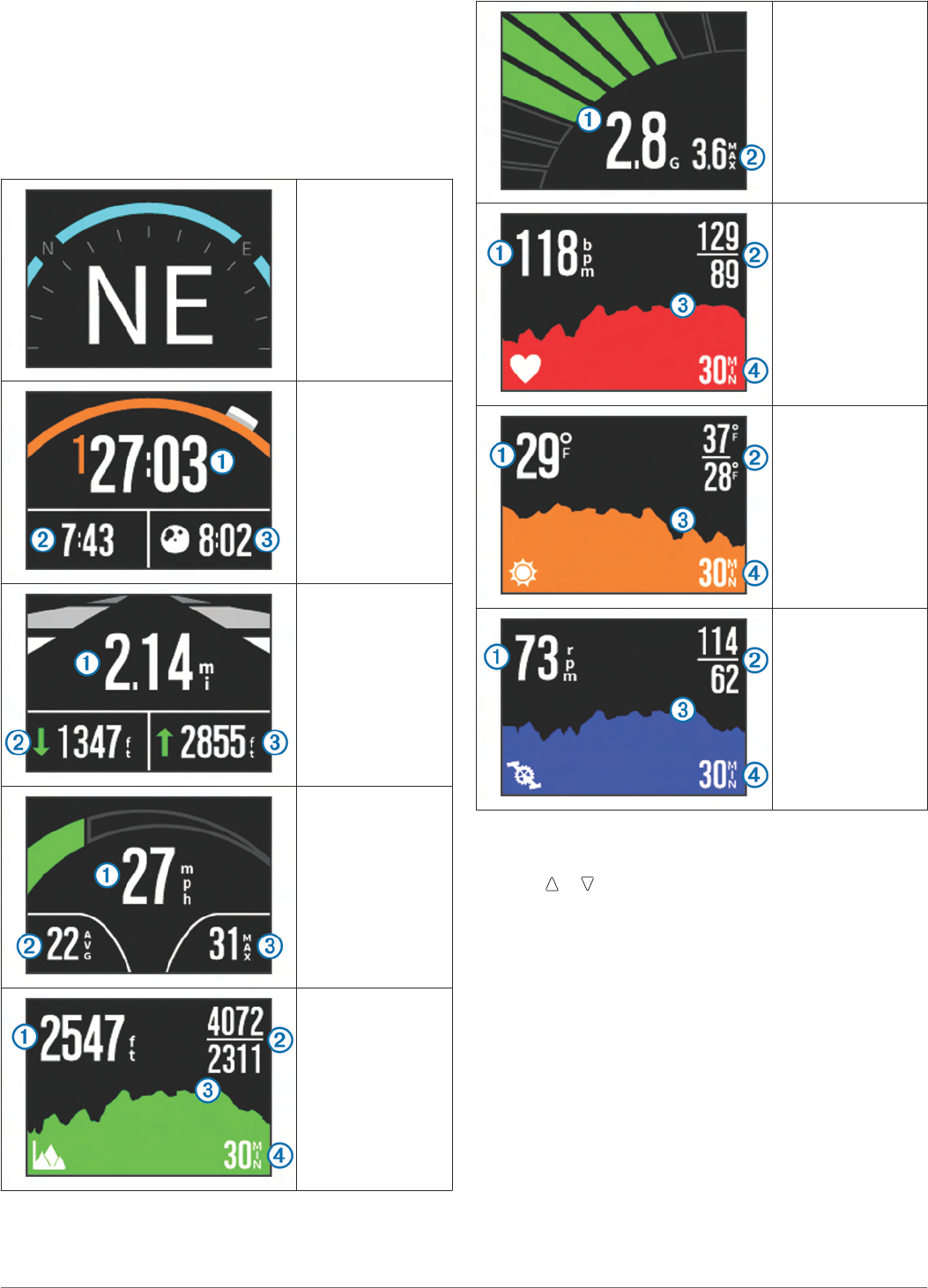
Dashboards
NOTE: This feature is available for VIRB Elite only.
A dashboard is a grouping of data fields, charts, or graphs of
data from the device sensors and connected ANT+ sensors.
The dashboards provide real-time and historical views of the
sensor data recorded to the track log.
NOTE: All minimum, maximum, and average dashboard data
resets after you turn off the device.
Compass displays the
current heading and
partial compass ring.
You must be moving to
use the compass.
Time displays the time
since the device was
turned on À, time of
day Á, and time of
sunset or sunrise Â.
Distance displays the
total distance À, total
descent Á, and total
ascent Â.
Speed displays the
current speed À,
average speed Á, and
maximum speed Â.
Elevation displays the
current elevation À,
maximum and
minimum elevations Á,
elevation graph Â, and
time scale Ã.
G-force displays the
current g-force
acceleration À and
maximum g-force
acceleration Á.
When connected to a
sensor, heart rate
displays the current
heart rate À, maximum
and minimum heart
rates Á, heart rate
graph Â, and time
scale Ã.
When connected to a
sensor, tempe displays
the current temperature
À, maximum and
minimum temperatures
Á, temperature graph
Â, and time scale Ã.
When connected to a
sensor, cadence
displays the current
cadence À, maximum
and minimum
cadences Á, cadence
graph Â, and time
scale Ã.
Viewing the Dashboards
1Select MODE > DASHBOARD.
2Select or to scroll through the dashboards.
Pairing Your ANT+ Sensors
When you pair a compatible ANT+ sensor with your device, the
sensor data is included in the track log, and you can view
dashboards for the sensor data.
1Turn on the sensor, and bring the device and sensor within
10 ft. (3 m) of each other.
2On the device, select MODE > SETUP > SENSORS.
3On the device, select the type of sensor to pair.
The icon for the sensor blinks. When the icon turns solid, the
sensor is paired and connected.
Remote Control
You can start recording, stop recording, and take pictures on
your VIRB device using another compatible Garmin device with
ANT+ wireless technology, such as the VIRB remote control
accessory or the fēnix™ watch. You can also use your VIRB
device to control other VIRB devices.
Dashboards 7

Controlling the Device Remotely
1On your VIRB device, select MODE > SETUP > Remote.
2Select VIRB Type > Main VIRB.
3Select an option:
• On the remote control device, launch the VIRB app or
feature. See the owner's manual for the device for more
information.
• On the remote control accessory, follow the pairing
instructions in the accessory manual.
Controlling Multiple VIRB Devices Remotely
When controlling multiple VIRB devices, you must choose a
main VIRB device. This device controls all your other VIRB
devices.
If you are using a remote control device with multiple VIRB
devices, the remote control device controls only the main VIRB
device. The main VIRB device passes commands received from
the remote control device to the other VIRB devices.
1On all of your VIRB devices, select MODE > SETUP >
Remote.
2On your main VIRB device, select VIRB Type > Main VIRB.
3On each of your other VIRB devices, select VIRB Type >
Extended VIRB.
REC on your main VIRB device starts and stops recording
video on all your VIRB devices. on your main VIRB device
takes a photo from all your VIRB devices.
4If you are using a remote control device, select an option:
• On the remote control device, launch the VIRB app or
feature. See the owner's manual for the device for more
information.
• On the remote control accessory, follow the pairing
instructions in the accessory manual.
Operating the Device Using Your Mobile
Device
NOTE: This feature is available for VIRB Elite only.
You can remotely view and control photo and video recording
using a compatible mobile device running the free Garmin VIRB
app. The app connects using a direct Wi-Fi connection between
your VIRB device and your compatible mobile device. Go to
www.garmin.com or the application store for your mobile device
for compatibility information.
1If necessary, install the Garmin VIRB app from the
application store on your mobile device.
2On your VIRB device, select MODE > SETUP > WIFI > WIFI.
The VIRB device enters wireless host mode, and the
SSID and password appear on the device screen.
3On your mobile device, go to the wireless settings and
connect to the wireless network that matches the SSID on
the VIRB device screen.
See the owner's manual for your mobile device for more
information.
4On your mobile device, enter the password that appears on
the VIRB device screen.
5On your mobile device, start the Garmin VIRB app.
Advanced Wireless Settings
You can change the wireless host settings for your device.
Select MODE > SETUP > WIFI > Advanced.
SSID: Sets the SSID, which identifies your VIRB device on
other devices.
Password: Sets the password used to connect to your VIRB
device.
Troubleshooting
My device does not turn on
• Install a memory card (page 1).
The device does not boot if a memory card is not installed.
• Verify the battery is installed correctly (page 1).
• Fully charge the battery (page 1).
My device display is hard to see
The device has a reflective display that maximizes battery life
and is readable in direct sunlight. The display does not have a
backlight and requires ambient light for visibility. If the display
looks dark or hard to see, you should increase the ambient light
or go to a brighter area.
Some information is missing from the
dashboards
Dashboards are available only for VIRB Elite devices (page 7).
Some dashboard information requires you to enable or pair
sensors.
• Enable GPS (page 8), and go to an area with a clear view
of the sky.
Location, speed, distance, and altitude information requires a
GPS signal.
• Connect additional ANT+ sensors (page 7).
Some dashboards are available only when a compatible
ANT+ sensor is connected.
My video recordings do not look smooth
• If video recordings appear shaky, select MODE > SETUP >
VIDEO > Lens Correct > On+Stabilize to enable image
stabilization.
• If video recordings stutter or skip frames, install a class 10 or
better microSD memory card (page 1).
The device requires a class 10 or better memory card to
record smooth high-definition video.
My device turns off when I stop recording
video
If you turn on the device by sliding REC toward the lens, the
device turns off when you slide REC away from the lens. This
allows you to maximize battery life by turning off the device
when it is not recording.
Device Information
System Settings
Select MODE > SETUP > SYSTEM.
GPS: Enables the device to receive GPS satellite signals.
When Recording enables GPS reception only when the
camera is recording video (VIRB Elite only).
NOTE: GPS must be set to On to enable Auto Record.
Record Light: Turns the recording light on or off.
Tones: Turns audible tones on or off.
Time: Sets the time and date formats.
Units: Sets the units of measure.
Language: Sets the on-screen text language.
Reset Settings: Restores the default device settings.
About: Displays important software information and your unit
ID.
8 Troubleshooting

Time Settings
Select MODE > SETUP > Time/Date.
Time: Sets the time.
NOTE: VIRB Elite devices set the time automatically when
you enable GPS.
Time Format: Sets the device to show time in a 12-hour or a
24-hour format.
Date: Sets the date.
NOTE: VIRB Elite devices set the date automatically when
you enable GPS.
Date Format: Sets the device to show dates in a MM/DD/YY or
a DD/MM/YY format.
Time Zone: Sets the time zone for the device. Automatic sets
the time zone automatically based on your GPS position
(VIRB Elite only).
Erasing Your Memory Card
NOTICE
Erased data cannot be restored.
You can erase all photos, videos, and other data on the memory
card installed in your device.
Select MODE > SETUP > CARD > Erase > OK.
Extending the Battery Life
NOTE: GPS and ANT™ do not significantly affect battery life.
• Disable Wi-Fi.
• Turn the device on and off using REC (page 3).
• Use automatic recording (page 4).
Device Care
NOTICE
Avoid chemical cleaners, solvents, and insect repellents that
can damage plastic components and finishes.
Do not store the device where prolonged exposure to extreme
temperatures can occur, because it can cause permanent
damage.
The device is water resistant to IEC Standard 60529 IPX7. It
can withstand immersion in 1 meter of water for 30 minutes.
Prolonged submersion can cause damage to the device. After
submersion, be certain to wipe dry and air dry the device before
using or charging.
Cleaning the Device
NOTICE
Do not use a dry cloth to clean the lens. Use of a dry cloth may
damage the fog resistant coating on the lens.
Wipe the device with a soft, non-scratch cloth dampened
with water or alcohol.
File Types
The device supports these file types.
• GPX track files (output only).
• JPEG photo files.
• MP4 video files.
• FIT files for exporting to Garmin Connect (output only).
Connecting the Device to Your Computer
NOTICE
To prevent corrosion, thoroughly dry the mini-USB port, the
weather cap, and the surrounding area before charging or
connecting to a computer.
Before you can connect the straight connector of the USB cable
to your device, you may have to remove optional mount
accessories.
1Pull up the weather cap from the mini-USB port.
2Plug the small end of the USB cable into the mini-USB port.
3Plug the large end of the USB cable into a computer USB
port.
Your device and memory card (optional) appear as
removable drives in My Computer on Windows® computers
and as mounted volumes on Mac® computers.
Support and Updates
The Garmin VIRB application provides easy access to these
tools and services for your device.
• Reviewing and editing recorded videos
• Reviewing track logs
• Linking track logs to your recorded videos
• Software and feature updates
The Garmin VIRB application is available for Windows and Mac
computers. Go to www.garmin.com/VIRB for more information.
Specifications
Battery type Rechargeable Lithium-ion battery
Battery life Up to 3 hours
Water resistance Water resistant to IEC 60529 IPX7
Operating temperature
range
From 5º to 140ºF (from -15º to 60ºC)
Charging temperature
range
From 32º to 113°F (0º to 45°C)
Radio frequency/
protocol
2.4 GHz ANT+ wireless communications
protocol
Wi-Fi IEEE 802.11 b/g at 2.4 GHz
Getting More Information
You can find more information about this product on the Garmin
website.
• Go to www.garmin.com/outdoor.
• Go to www.garmin.com/learningcenter.
• Go to http://buy.garmin.com, or contact your Garmin dealer
for information about optional accessories and replacement
parts.
Device Information 9

Index
A
accessories 9
ANT+ sensors 3
pairing 7
B
battery 1, 8, 9
charging 1
installing 1
life 9
C
cadence 6
camera
field of view 4
level 3
modes 3
orientation 4
self timer 5
settings 3, 5
viewfinder 3
charging 1
cleaning the device 9
computer, connecting 9
D
dashboards 7, 8
data, transferring 9
deleting
all user data 9
pictures 6
videos 6
device, keys 2
E
elevation 6
F
files, transferring 9
G
GPS 6
settings 3, 8
H
HDMI output 6
headphones, connecting 6
heart rate 6
K
keys 2
L
language 8
M
memory card 1
microphone, connecting 5
microSD card. See memory card
mounting the device 2
mounts, optional 2
P
photos
settings 4, 5
taking 5
viewing 5
power key 2, 3
R
remote control 7, 8
S
settings 9
software
updating 9
version 8
specifications 9
speed 6
storing data 9
system settings 8
T
temperature 6, 9
time
settings 9
zones and formats 9
tones 8
tracks 6, 9
transferring, files 9
troubleshooting 8, 9
U
unit ID 8
USB
mass storage mode 9
transferring files 9
V
video
editing 9
loop 5
output 6
playing 5
recording 3–5
settings 3, 4
time lapse 4
volume, adjusting 6
W
water resistance 9
Wi-Fi 3, 8
connecting 8
10 Index

www.garmin.com/support
913-397-8200
1-800-800-1020
0808 238 0000
+44 870 850 1242 1-866-429-9296 +43 (0) 820 220 230
+32 2 672 52 54 +45 4810 5050 +358 9 6937 9758 + 331 55 69 33 99
+49 (0)180 6 427646 + 39 02 36 699699 0800 - 023 3937
035 - 539 3727 + 47 815 69 555
00800 4412 454
+44 2380 662 915 + 35 1214 447 460 + 34 93 275 44 97 + 46 7744 52020
Garmin International, Inc.
1200 East 151st Street
Olathe, Kansas 66062, USA
Garmin (Europe) Ltd.
Liberty House, Hounsdown Business Park
Southampton, Hampshire, SO40 9LR UK
Garmin Corporation
No. 68, Zhangshu 2nd Road, Xizhi Dist.
New Taipei City, 221, Taiwan (R.O.C.)
© 2013 Garmin Ltd. or its subsidiaries
Notice
This device complies with Part 15 of the FCC Rules. Operation is subject to the
following two
conditions: (1) this device may not cause harmful interference and (2) this
device must accept any interference received, including interference that may
cause undesired operation.
For P15B equipment
This equipment has been tested and found to comply with the limits for a Class
B digital device, pursuant to part 15 of the FCC rules. These limits are
designed to provide reasonable protection against harmful interference in a
residential installation. This equipment generates, uses and can radiate radio
frequency energy and, if not installed and used in accordance with the
instructions, may cause harmful interference to radio communications.
However, there is no guarantee that interference will not occur in a particular
installation. If this equipment does cause harmful interference to radio or
television reception, which can be determined by turning the equipment off and
on, the user is encouraged to try to correct the interference by one or more of
the following measures:
-Reorient or relocate the receiving antenna.
-Increase the separation between the equipment and receiver.
-Connect the equipment into an outlet on a circuit different from that to which
the receiver is connected.
-Consult the dealer or an experienced radio/TV technician for help.
Any changes or modifications not expressly approved by the party responsible for
compliance could void the user's authority to operate this equipment.
FCC RF Radiation Exposure Statement:
(1) This Transmitter has been demonstrated co-location compliance requirements
as documented in this filing.
(2) This equipment complies with FCC RF radiation exposure limits set forth for an
uncontrolled environment.
Canada—Low‐powerlicense‐exemptradiocommunicationdevices(RSS‐210)
a.Commoninformation
Operationissubjecttothefollowingtwoconditions:
1.Thisdevicemaynotcauseinterference,and
2.Thisdevicemustacceptanyinterference,includinginterferencethatmaycauseundesired
operationofthedevice.
b.Operationin2.4GHzbandTopreventradiointerferencetothelicensedservice,thisdevice
isintendedtobeoperatedindoorsandinstallationoutdoorsissubjecttolicensing.
Canada‐defaiblepuissanceexemptsdelicencedesappareilsdecommunicationradio(CNR‐210)
a.Informationscommunes
Sonfonctionnementestsoumisauxdeuxconditionssuivantes:
1.Cedispositifnepeutcauserdesinterférences,et
2.Cedispositifdoitacceptertouteinterférence,ycomprislesinterférencesquipeuventcauserun
mauvais
fonctionnementdudispositif.
b.Lefonctionnementenbandede2,4GHzPourprévenirlesinterférencesradioélectriquesauxservices
souslicence,
cetappareilestdestinéàêtreexploitéàl'intérieuretàl'extérieurd'installationestsoumiseàlicence.
ICradiationexposurestatementThisEUTiscompliancewithSARforgeneralpopulation/uncontrolled
exposure
limitsinICRSS‐102andhadbeentestedinaccordancewiththemeasurementmethodsandprocedures
specifiedin
IEEE1528.Thisdeviceanditsantenna(s)mustnotbeco‐locatedoroperatinginconjunctionwithany
otherantenna
ortransmitter.Note:ThecountycodeselectionfeatureisdisabledforproductsmarketedintheUS/Canada.
DéclarationICexpositionauxrayonnementsCetteESTestlerespectdeSARpourlapopulationgénérale
/limites
d'expositionnoncontrôléedanslesICRSS‐102etaététestéconformémentauxméthodesetprocédures
demesure
spécifiéesdanslanormeIEEE1528.Cetappareiletsonantenne(s)nedoitpasêtreco‐localisésou
fonctionner
conjointementavecuneautreantenneoutransmetteur.Remarque:Lafonctioncodedecomtéde
sélectionest
désactivéepourlesproduitscommercialisésdanslesÉtats‐UnisetleCanada.